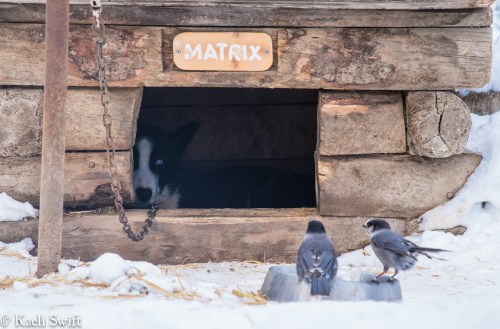When I was still in Alaska back in the fall, my social media was brimming with pictures of the kinds of things you might expect from a biologist studying birds in Denali National Park. Photos of bears, Canada jays, arctic tundra, caribou, snowshoe hares, ravens, mountain and…puppies? Not just the occasional pupper photo either, but piles of puppies, puppies on parade, and videos of puppies doing the kinds of pupper things that make even the most cold-souled of us go red with glee.

Most of you were probably thinking, “IDK why this is happening and I don’t care, just give me more,” but a few of you may have found it a bit odd that I appeared to be spending so much of my time with doggos rather than the birds I was in Alaska to study. But, no matter which camp you were in, let me take a moment to clear the air and confirm that my time around the puppies was purely professional.
Let’s start with a fact that is not well known among the general public, but is crucial to the story: Denali is the only National Park with a full-time sled-dog team. In fact, Denali has had a mushing team since 1922, starting merely five years after the park’s inception. At that time, the team was responsible for patrolling the park boundary for poachers. Today, the dogs help deliver supplies and humans to places within the park that become difficult to reach during the winter months.
In any given year, the park is home to about 35 dogs, which when not working live in the kennels near park headquarters. As a park visitor, you can go to the kennels to meet the dogs and see mushing demonstrations. Needless to say between its cultural significance and popularity with the public, the kennels at Denali are a source of pride and joy for many park visitors and staff.
There is one aspect of the kennels, however, that makes their presence a bit tricky from a wildlife perspective. Like all US National Parks, Denali maintains a dogmatic “no-feeding wildlife” policy. This is meant to keep wildlife wild and prevent dependency and human conflict. Feeding time at the kennels, however, can be a real smorgasbord for the local corvids, particularly if some of the dogs are slow or reluctant to eat. How such food supplementation may be affecting the breeding success (or mortality) of the jays is therefore of keen interest to my work.

In partnership with kennel staff, my tech and I sought to document which birds were attending the daily feeding at the kennels. I will do the same come the winter field season, and ultimately we hope to determine if such attendance has any impact on how many fledglings those pairs are able to produce.

So, as I said, while visiting the kennels and the park’s annual litter is all fun and games for most, for me it was serious, professional science business and nothing more. Can’t you tell?










Ola
Muito interessante
Nunca conheceria isto
Tudo de bom
I have wondered about this kind of stuff. I feed ravens cat food for the fun of it and because I want them to survive the Maine winter. Foxes also come to the dinner table. I want the foxes to be healthy because they eat lots of white footed mice that are host to the tick nymphs that carry Lyme disease. I hope all of this is a good thing. The tick population seems to have gone down and that’s a good thing.
Were those puppers playful? Asking for science….
Love you’re enthusiasm, love this blog 🙏🙏
Great story. I just lost my snow dog, and the puppy pictures are so inviting. I’ll post a memorial to my dog on my blog in a few days. She never got to Alaska, but she thrived in the Cascades.
Pingback: Watching puppies…for science – ExploreDogs.com
If I’m not paying attention, my pooches tend to vacuum up the sunflower seed I’ve scattered for groundfeeding sparrows and finches. What goes around, comes around?
Nice story & great experience. U r so enthusiastic. Pinned this blog.